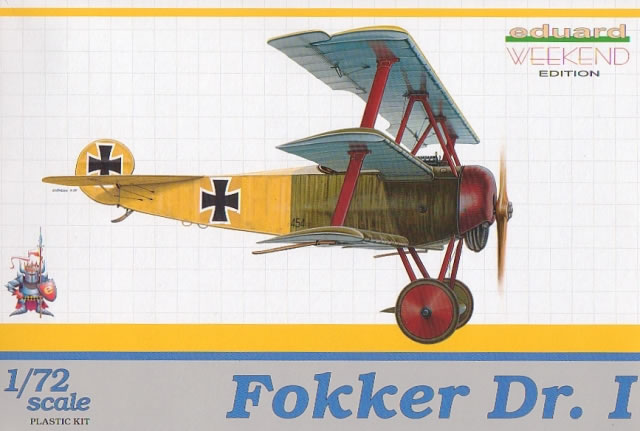|
Fokker Dr.I
Weekend Edition

Eduard, 1/72 scale
S
u m m a r y |
| Catalogue Number: |
Eduard Kit No. 7405 - Fokker Dr.I Weekend Edition |
| Scale: |
1/72 |
| Contents and Media: |
163 parts in tan coloured plastic; markings for one aircraft |
| Price: |
USD$14.95 available online from Eduard
and hobby retailers worldwide |
| Review Type: |
FirstLook |
| Advantages: |
Excellent detail; flawless moulding; simple assembly; wings with subtle rib detail and sharp trailing edges; decals in perfect register with minimal carrier film. |
| Disadvantages: |
|
| Conclusion: |
A budget priced “no frills” kit that allows for quick and easy assembly. Without the complexity of photo-etched parts, the modeller can concentrate on finishing a subject with nothing more than a basic set of skills. |
Reviewed by
Rob Baumgartner

Eduard's 1/72 Weekend Edition Fokker Dr.I is available online from Squadron.com
The Fokker triplane has always been a favourite subject with early aviation modellers so this release from Eduard is bound to please.
It follows the traditional format of a “Weekend Edition” kit, which means we get all the plastic from earlier incarnations but without the detailing accessories. This translates into a simplified build but also means a quicker and easier one.
The plastic parts are all contained on a single tree and consist of 38 tan coloured pieces. They are beautifully moulded with no flaws or imperfections of any kind. Sinks marks are also nonexistent and the few ejector pins present have been cleverly hidden on the finished product.
The fuselage is a complex shape and it’s captured very well by this manufacturer. The interior shows a representation of the tubular structure as well as a compass, magneto and auxiliary throttle. Surprisingly Eduard chose not to replicate the triangular wooden formers. Instead they use the instruction sheet to ask the modeller to imitate these with paint.
Other items supplied for the cockpit area include the floor, rudder bar, control column, seat and rear “fabric” screen.
Each flying surface is moulded as a single piece and this makes assembly very easy. The parts exhibit subtle rib detail and an exquisite depiction of the leading edge plywood sheathing. The trailing edges are sharp and where necessary, there are integrally moulded control horns and this really adds to the build-ability of the kit.
Despite the excellent detail, there are a couple of areas that the fastidious will want to change. First is the celluloid inspection window that’s found on top of the upper wing. This should be moved slightly forward so that it’s located over the main spar. The kit also portrays fasteners on the undercarriage wing which assumes that the lifting surface could be split for maintenance purposes. This wasn’t the case but a few swipes with wet ‘n dry will easily eradicate them. These discrepancies are due to Eduard using references that have since been revised.
Overall, assembly is generally straight forward with only some of the smaller items needing a bit of careful dry-fitting. The wings line up perfectly thanks to the single piece struts and the minimal rigging makes this an ideal subject for the WWI first-timer.
Marking Option
As this is a “Weekend Edition” kit, there is a single markings scheme contained in the box. It is the mount of Lothar von Richthofen and is one of the more popular colour schemes for triplane modellers.

The decals reside on a single sheet of paper and all items were in perfect register. The minimal carrier film was thin and experience shows that they adhere well to their chosen surface.
Aside from the national markings, there are also instrument dials to be found and these are supplemented by a weights table, Axial propeller logos, datum line and stitching.
Lothar was quite the opposite of his brother when it came to being a fighter pilot. It is said that while Manfred was patient and cunning in his approach to fighting the enemy, Lothar would charge into a contest with reckless abandon. This would explain his remarkable achievement of 40 victories in just 77 days of actual combat flying. It would also account for the numerous injuries he collected along the way.
Ironically Lothar was the one to survive the war, only to meet his death in an accident on the 4 July 1922.
These Weekend Edition releases are the ideal way to get you out of a modelling slump.
As the name implies, they give the purchaser an opportunity to build a subject quickly and with a minimum of fuss. All of the essential parts are catered for and importantly the outline of these components accord well with published references. Triplane diehards will change a couple of minor details but these modifications are well within the scope of anyone that has built a model before.
The choice of scheme is straightforward enough and if that one doesn’t suit, this manifestation is a cheap way of starting your own Jasta.
Thanks to Eduard for the sample
Review Text Copyright © 2009 by Rob Baumgartner
Page Created 13 October, 2009
Last updated
13 October, 2009
Back to HyperScale Main Page
Back to Reviews Page

|
